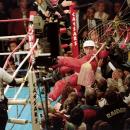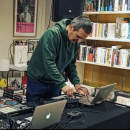Hola amigos acá les dejo un buen articulo ..
Recording and mixing audio is truly an art form unto itself. Like playing bass, it’s the type of thing most people can pickup quickly and without much effort. Getting good at it can take years, however.
I’ve been recording in my home studio since 1995. When I go back and listen to my early demos, I am appalled. They sound horrific. The EQ is terrible, they are overly compressed, they’re muddy, and all of the tracks blend together into a massive “wall of sound” where no single instrument stands out. But I like to think my current work sounds infinitely better. Take a listen to the tracks on my Demos page. I mixed these in 2006 on a shoestring budget. My entire recording “studio” cost me $500. I used budget mics, budget preamps, and budget PC audio interfaces. (One interesting note: In the song Confession, I used a $400 mic on the words “Am I going crazy? Could you ever turn your eyes my way?” The rest of the song was recorded with a $65 microphone. To this day I can’t hear any difference in quality.)
What was the secret to making better mixes? It was simple. I listened.
I would listen to my mixes over, and over, and over, and then do it again. I listened to my songs on headphones, in my car, in my girlfriend’s car, on my home stereo system, on a portable CD player, etc. During every listening session I would find something that could be improved. Over time, I figured out the fundamental principles of good mixing. I also read plenty of industry magazines, online articles, Internet forums, and whatever else I could find that would enlighten a novice like me. In the end, I was able to produce mixes I was very happy with.
Here, then, are the biggest nuggets of wisdom I wish someone had preached to me in my early days:
You don’t need expensive gear. That’s right. Despite what manufacturers and retailers may say, the secret to good sound is not in the equipment. Using poor recording and mixing techniques on expensive gear will still result in a bad final product. It doesn’t matter how nice your API preamp or LA-2A compressor is. If you don’t know what you’re doing, the results will be garbage. Just like buying a custom Les Paul won’t make you sound like Jimmy Page! Once you’re able to produce good mixes on budget gear, you can justify a gear upgrade.
A little processing goes a long way. The abundance of VST and RTAS plugins is both a blessing and a curse. We musicians now have access to an endless collection of software compressors, equalizers, limiters, enhancers, reverbs, etc. But with this power comes responsibility. Use them sparingly! I once held the opinion that because I had tons of plugins at my disposal, I needed to use all of them as much as possible. I was wrong. Excessive plugin use can ruin a mix. These days I use very light compression and very subtle EQ adjustments, and the results sound much more natural.
Create “space” for each track. Every instrument should have its own “space” in the mix. By “space” I’m referring to track identity…the things that separate each track from the others, so they can be heard properly. Think of this way: When you take a big family photo, how is everyone positioned? Does everyone clump together randomly? Or does everyone organize according to height and spread out evenly? Your mixes are like musical photographs. Think of each track as an individual that should be noticed in some way. Track “space” can be created by using proper EQ techniques, stereo field placement, volume, compression, and reverb/delay settings. For example, bass guitar and kick drum occupy much of the same frequency range. If each is not EQ’d intelligently, they will step all over each other, and neither will be identifiable. There are tons of good Internet articles on this subject, so read up. I may even write one myself.
Understand how EQ and Compression works. You’ll be amazed at how much better your mixes will sound if you use proper EQ and Compressor techniques. Each has its own set of rules, and the rules are specific for each type of instrument. For instance, electric guitar requires different EQ and Compressor settings than do vocals. Drums usually need a fast attack and quick release on the Compressor, while the opposite is true for bass. Again, there are plenty of online articles dedicated to this subject alone.
Carefully evaluate the mixes of your favorite artists. Everyone has their own taste. Whatever artist(s) inspire you with their sound, pay attention to the mix. Is it heavy on bass? Are the drums super compressed? Are the vocals subdued, or way out front? Study the sound carefully and try to emulate it. I’ve spent almost as much time listening to the sound of professional CD mixes as I have listening to my own. It’s very educational.
Last, but not least: DO NOT OVERCOMPRESS YOUR MASTER. You may not be aware, but there is a current trend in the recording industry to make every CD louder than its competitors. This is known as the “loudness war” and it is getting out of hand. Using insane levels of compression destroys the dynamics (the change between quiet and loud parts) of a mix. The end result is a song that stays at exactly the same level—insanely loud—the entire time. Not only does it sound unnatural, it causes listener “fatigue”. The human ear wants to hear natural changes in volume. It helps create more emotion in the listener. Your heavy and energetic chorus will have much more impact if it’s actually louder than your verse! Be a part of the solution: Use your compressor and limiter wisely during the mastering stage! Even for rock music, you probably don’t want more than 3db of compression during your mastering.
That’s it for this article. I plan to write follow up articles that examine these topics, and more, in more detail. I hope this has been helpful.
--------
traducción por google
Grabación y mezcla de audio es realmente una forma de arte á sí mismo. Al igual que tocar el bajo, es el tipo de cosa mayoría de la gente puede recoger de forma rápida y sin mucho esfuerzo. Cómo bien se puede tomar años, sin embargo.
He estado grabando en mi casa desde 1995. Cuando vuelvo a escuchar a mis primeros demos, me horroriza. Suenan horribles. El EQ es terrible, son excesivamente comprimido, son de barro, y todas las pistas se funden en un gran "muro de sonido", donde no solo instrumento se destaca. Pero me gusta pensar que mi trabajo actual suena infinitamente mejor. Tome un escuchar las pistas en mi página de Demos. He mezclado estos en 2006 con un presupuesto reducido. Mi grabación completa "estudio" me costó 500 dólares. Yo micrófonos presupuesto, preamplificadores de presupuesto, presupuesto y PC interfaces de audio. (Una nota interesante: En la canción Confesión, he utilizado un micrófono $ 400 en las palabras "¿Me estoy volviendo loco? ¿Podría alguna vez vuelve los ojos a mi manera?" El resto de la canción fue grabada con un micrófono de 65 dólares. Para el día de hoy No se oye ninguna diferencia en la calidad.)
¿Cuál fue el secreto para hacer mejores mezclas? Era muy sencillo. He escuchado.
Me gustaría escuchar a mis mezclas más, y otra vez, y otra vez, y luego hacerlo de nuevo. He escuchado a mis canciones en los auriculares, en mi coche, en el coche de mi novia, en mi sistema estéreo doméstico, en un reproductor de CD portátil, etc Durante cada sesión de escucha que iba a encontrar algo que podría mejorarse. Con el tiempo, me di cuenta de los principios fundamentales de una buena mezcla. Yo también he leído un montón de revistas de la industria, artículos en línea, foros de Internet, y todo lo que pude encontrar que ilumine un novato como yo. Al final, fui capaz de producir mezclas Yo estaba muy feliz.
Aquí, entonces, son los mayores pepitas de sabiduría deseo que alguien había predicado a mí en mis primeros días:
Usted no necesita equipo caro. Eso es. A pesar de lo que los fabricantes y los minoristas pueden decir, el secreto para un buen sonido no está en el equipo. Utilizando una grabación pobres y las técnicas de mezcla en artes caro aún resultará en un producto final malo. No importa cómo es agradable su preamplificador o un compresor API LA-2A es. Si no sabes lo que estás haciendo, los resultados serán basura. Al igual que la compra de una costumbre Les Paul no le hará sonar como Jimmy Page! Una vez que esté en condiciones de producir una buena mezcla de artes de presupuesto, puede justificar una actualización de engranajes.
Un proceso poco va un largo camino. La abundancia de plugins VST y RTAS es a la vez una bendición y una maldición. Nosotros los músicos tienen ahora acceso a una colección interminable de compresores de software, ecualizadores, limitadores, los potenciadores, reverberaciones, etc, pero con este poder viene la responsabilidad. Úselos con moderación! Una vez celebrada la opinión de que porque había toneladas de plugins a mi disposición, que tenía que usar todos ellos tanto como sea posible. Me equivoqué. el uso excesivo plugin puede arruinar una mezcla. En estos días el uso de compresión muy ligero y los ajustes EQ muy sutil, y los resultados de sonido mucho más natural.
Crear el "espacio" para cada pista. Cada instrumento debe tener su propio "espacio" en la mezcla. Por "espacio" me refiero a la pista de identidad ... las cosas que separan a cada pista de los demás, por lo que se puede escuchar correctamente. Piense de esta manera: Cuando usted toma una foto de gran familia, ¿cómo es cada uno colocado? ¿Se agrupan todos juntos al azar? ¿O es que todo el mundo organizan de acuerdo con la altura y distribuyen de manera uniforme? Su mezcla son como fotografías musical. Piense en cada pista como un individuo que debe ser observado de alguna manera. Track "espacio" se puede crear mediante el uso de técnicas adecuadas de EQ, la colocación campo estéreo, el volumen, la compresión y reverb / ajustes de retardo. Por ejemplo, bajo y bombo ocupan gran parte de la misma gama de frecuencias. Si cada uno no es del EQ de forma inteligente, se paso todo entre sí, y no serán identificables. Hay toneladas de artículos de Internet bien en este tema para leer. Incluso puede escribir uno yo mismo.
Entender cómo funciona EQ y compresión. Usted se sorprenderá de lo mucho mejor que sus mezclas sonará si el uso adecuado de EQ y técnicas del compresor. Cada uno tiene su propio conjunto de reglas, y las reglas son específicas para cada tipo de instrumento. Por ejemplo, la guitarra eléctrica requiere diferentes configuraciones de EQ y compresor de hacer la voz. Tambores por lo general necesitan un ataque rápido y liberación rápida en el compresor, mientras que lo contrario es cierto para el bajo. Una vez más, hay un montón de artículos en línea dedicada a este tema solo.
Evalúe cuidadosamente las mezclas de tus artistas favoritos. Cada uno tiene su propio gusto. Cualquiera que sea artista (s) que inspiran con su sonido, ponga atención a la mezcla. ¿Es pesada en el bajo? Son los tambores super comprimido? ¿Son las voces moderadas, o la manera en el frente? Estudio del sonido con cuidado y tratar de emular. Me he pasado casi todo el tiempo escuchando el sonido de CD mezclas profesionales como he escuchando a la mía. Es muy educativo.
Por último, pero no menos importante: NO SU MASTER OVERCOMPRESS. Usted no puede estar al tanto, pero hay una tendencia actual en la industria de la grabación de CD a hacer todo lo más fuerte que sus competidores. Esto se conoce como la guerra de volumen "y se nos está yendo de las manos. Uso de los niveles de compresión loco destruye la dinámica (el cambio entre las partes tranquilo y fuerte) de una mezcla. El resultado final es una canción que se mantiene exactamente en el mismo nivel increíblemente alto-todo el tiempo. No sólo el sonido poco natural, hace que escucha "la fatiga". El oído humano quiere conocer los cambios naturales en el volumen. Ayuda a crear más emoción en el oyente. Su coro pesada y energética tendrá un impacto mucho más si en realidad es más fuerte que su verso! Sea parte de la solución: utilizar su compresor y limitador sabiamente durante la etapa de masterización! Incluso para la música rock, es probable que no quieren más que 3db de compresión durante su dominio.
Escrito por :
Make music,
Dan
About the Author
Bassist, Songwriter, and Recording Engineer. View my site for music articles, demos, and more.
www.DanAtkinson.net
dan-atkinson.blogspot.com
(ArticlesBase SC #524259)
Article Source: http://www.articlesbase.com/ – Recording Tips: How to Make Better Mixes
Recording and mixing audio is truly an art form unto itself. Like playing bass, it’s the type of thing most people can pickup quickly and without much effort. Getting good at it can take years, however.
I’ve been recording in my home studio since 1995. When I go back and listen to my early demos, I am appalled. They sound horrific. The EQ is terrible, they are overly compressed, they’re muddy, and all of the tracks blend together into a massive “wall of sound” where no single instrument stands out. But I like to think my current work sounds infinitely better. Take a listen to the tracks on my Demos page. I mixed these in 2006 on a shoestring budget. My entire recording “studio” cost me $500. I used budget mics, budget preamps, and budget PC audio interfaces. (One interesting note: In the song Confession, I used a $400 mic on the words “Am I going crazy? Could you ever turn your eyes my way?” The rest of the song was recorded with a $65 microphone. To this day I can’t hear any difference in quality.)
What was the secret to making better mixes? It was simple. I listened.
I would listen to my mixes over, and over, and over, and then do it again. I listened to my songs on headphones, in my car, in my girlfriend’s car, on my home stereo system, on a portable CD player, etc. During every listening session I would find something that could be improved. Over time, I figured out the fundamental principles of good mixing. I also read plenty of industry magazines, online articles, Internet forums, and whatever else I could find that would enlighten a novice like me. In the end, I was able to produce mixes I was very happy with.
Here, then, are the biggest nuggets of wisdom I wish someone had preached to me in my early days:
You don’t need expensive gear. That’s right. Despite what manufacturers and retailers may say, the secret to good sound is not in the equipment. Using poor recording and mixing techniques on expensive gear will still result in a bad final product. It doesn’t matter how nice your API preamp or LA-2A compressor is. If you don’t know what you’re doing, the results will be garbage. Just like buying a custom Les Paul won’t make you sound like Jimmy Page! Once you’re able to produce good mixes on budget gear, you can justify a gear upgrade.
A little processing goes a long way. The abundance of VST and RTAS plugins is both a blessing and a curse. We musicians now have access to an endless collection of software compressors, equalizers, limiters, enhancers, reverbs, etc. But with this power comes responsibility. Use them sparingly! I once held the opinion that because I had tons of plugins at my disposal, I needed to use all of them as much as possible. I was wrong. Excessive plugin use can ruin a mix. These days I use very light compression and very subtle EQ adjustments, and the results sound much more natural.
Create “space” for each track. Every instrument should have its own “space” in the mix. By “space” I’m referring to track identity…the things that separate each track from the others, so they can be heard properly. Think of this way: When you take a big family photo, how is everyone positioned? Does everyone clump together randomly? Or does everyone organize according to height and spread out evenly? Your mixes are like musical photographs. Think of each track as an individual that should be noticed in some way. Track “space” can be created by using proper EQ techniques, stereo field placement, volume, compression, and reverb/delay settings. For example, bass guitar and kick drum occupy much of the same frequency range. If each is not EQ’d intelligently, they will step all over each other, and neither will be identifiable. There are tons of good Internet articles on this subject, so read up. I may even write one myself.
Understand how EQ and Compression works. You’ll be amazed at how much better your mixes will sound if you use proper EQ and Compressor techniques. Each has its own set of rules, and the rules are specific for each type of instrument. For instance, electric guitar requires different EQ and Compressor settings than do vocals. Drums usually need a fast attack and quick release on the Compressor, while the opposite is true for bass. Again, there are plenty of online articles dedicated to this subject alone.
Carefully evaluate the mixes of your favorite artists. Everyone has their own taste. Whatever artist(s) inspire you with their sound, pay attention to the mix. Is it heavy on bass? Are the drums super compressed? Are the vocals subdued, or way out front? Study the sound carefully and try to emulate it. I’ve spent almost as much time listening to the sound of professional CD mixes as I have listening to my own. It’s very educational.
Last, but not least: DO NOT OVERCOMPRESS YOUR MASTER. You may not be aware, but there is a current trend in the recording industry to make every CD louder than its competitors. This is known as the “loudness war” and it is getting out of hand. Using insane levels of compression destroys the dynamics (the change between quiet and loud parts) of a mix. The end result is a song that stays at exactly the same level—insanely loud—the entire time. Not only does it sound unnatural, it causes listener “fatigue”. The human ear wants to hear natural changes in volume. It helps create more emotion in the listener. Your heavy and energetic chorus will have much more impact if it’s actually louder than your verse! Be a part of the solution: Use your compressor and limiter wisely during the mastering stage! Even for rock music, you probably don’t want more than 3db of compression during your mastering.
That’s it for this article. I plan to write follow up articles that examine these topics, and more, in more detail. I hope this has been helpful.
--------
traducción por google
Grabación y mezcla de audio es realmente una forma de arte á sí mismo. Al igual que tocar el bajo, es el tipo de cosa mayoría de la gente puede recoger de forma rápida y sin mucho esfuerzo. Cómo bien se puede tomar años, sin embargo.
He estado grabando en mi casa desde 1995. Cuando vuelvo a escuchar a mis primeros demos, me horroriza. Suenan horribles. El EQ es terrible, son excesivamente comprimido, son de barro, y todas las pistas se funden en un gran "muro de sonido", donde no solo instrumento se destaca. Pero me gusta pensar que mi trabajo actual suena infinitamente mejor. Tome un escuchar las pistas en mi página de Demos. He mezclado estos en 2006 con un presupuesto reducido. Mi grabación completa "estudio" me costó 500 dólares. Yo micrófonos presupuesto, preamplificadores de presupuesto, presupuesto y PC interfaces de audio. (Una nota interesante: En la canción Confesión, he utilizado un micrófono $ 400 en las palabras "¿Me estoy volviendo loco? ¿Podría alguna vez vuelve los ojos a mi manera?" El resto de la canción fue grabada con un micrófono de 65 dólares. Para el día de hoy No se oye ninguna diferencia en la calidad.)
¿Cuál fue el secreto para hacer mejores mezclas? Era muy sencillo. He escuchado.
Me gustaría escuchar a mis mezclas más, y otra vez, y otra vez, y luego hacerlo de nuevo. He escuchado a mis canciones en los auriculares, en mi coche, en el coche de mi novia, en mi sistema estéreo doméstico, en un reproductor de CD portátil, etc Durante cada sesión de escucha que iba a encontrar algo que podría mejorarse. Con el tiempo, me di cuenta de los principios fundamentales de una buena mezcla. Yo también he leído un montón de revistas de la industria, artículos en línea, foros de Internet, y todo lo que pude encontrar que ilumine un novato como yo. Al final, fui capaz de producir mezclas Yo estaba muy feliz.
Aquí, entonces, son los mayores pepitas de sabiduría deseo que alguien había predicado a mí en mis primeros días:
Usted no necesita equipo caro. Eso es. A pesar de lo que los fabricantes y los minoristas pueden decir, el secreto para un buen sonido no está en el equipo. Utilizando una grabación pobres y las técnicas de mezcla en artes caro aún resultará en un producto final malo. No importa cómo es agradable su preamplificador o un compresor API LA-2A es. Si no sabes lo que estás haciendo, los resultados serán basura. Al igual que la compra de una costumbre Les Paul no le hará sonar como Jimmy Page! Una vez que esté en condiciones de producir una buena mezcla de artes de presupuesto, puede justificar una actualización de engranajes.
Un proceso poco va un largo camino. La abundancia de plugins VST y RTAS es a la vez una bendición y una maldición. Nosotros los músicos tienen ahora acceso a una colección interminable de compresores de software, ecualizadores, limitadores, los potenciadores, reverberaciones, etc, pero con este poder viene la responsabilidad. Úselos con moderación! Una vez celebrada la opinión de que porque había toneladas de plugins a mi disposición, que tenía que usar todos ellos tanto como sea posible. Me equivoqué. el uso excesivo plugin puede arruinar una mezcla. En estos días el uso de compresión muy ligero y los ajustes EQ muy sutil, y los resultados de sonido mucho más natural.
Crear el "espacio" para cada pista. Cada instrumento debe tener su propio "espacio" en la mezcla. Por "espacio" me refiero a la pista de identidad ... las cosas que separan a cada pista de los demás, por lo que se puede escuchar correctamente. Piense de esta manera: Cuando usted toma una foto de gran familia, ¿cómo es cada uno colocado? ¿Se agrupan todos juntos al azar? ¿O es que todo el mundo organizan de acuerdo con la altura y distribuyen de manera uniforme? Su mezcla son como fotografías musical. Piense en cada pista como un individuo que debe ser observado de alguna manera. Track "espacio" se puede crear mediante el uso de técnicas adecuadas de EQ, la colocación campo estéreo, el volumen, la compresión y reverb / ajustes de retardo. Por ejemplo, bajo y bombo ocupan gran parte de la misma gama de frecuencias. Si cada uno no es del EQ de forma inteligente, se paso todo entre sí, y no serán identificables. Hay toneladas de artículos de Internet bien en este tema para leer. Incluso puede escribir uno yo mismo.
Entender cómo funciona EQ y compresión. Usted se sorprenderá de lo mucho mejor que sus mezclas sonará si el uso adecuado de EQ y técnicas del compresor. Cada uno tiene su propio conjunto de reglas, y las reglas son específicas para cada tipo de instrumento. Por ejemplo, la guitarra eléctrica requiere diferentes configuraciones de EQ y compresor de hacer la voz. Tambores por lo general necesitan un ataque rápido y liberación rápida en el compresor, mientras que lo contrario es cierto para el bajo. Una vez más, hay un montón de artículos en línea dedicada a este tema solo.
Evalúe cuidadosamente las mezclas de tus artistas favoritos. Cada uno tiene su propio gusto. Cualquiera que sea artista (s) que inspiran con su sonido, ponga atención a la mezcla. ¿Es pesada en el bajo? Son los tambores super comprimido? ¿Son las voces moderadas, o la manera en el frente? Estudio del sonido con cuidado y tratar de emular. Me he pasado casi todo el tiempo escuchando el sonido de CD mezclas profesionales como he escuchando a la mía. Es muy educativo.
Por último, pero no menos importante: NO SU MASTER OVERCOMPRESS. Usted no puede estar al tanto, pero hay una tendencia actual en la industria de la grabación de CD a hacer todo lo más fuerte que sus competidores. Esto se conoce como la guerra de volumen "y se nos está yendo de las manos. Uso de los niveles de compresión loco destruye la dinámica (el cambio entre las partes tranquilo y fuerte) de una mezcla. El resultado final es una canción que se mantiene exactamente en el mismo nivel increíblemente alto-todo el tiempo. No sólo el sonido poco natural, hace que escucha "la fatiga". El oído humano quiere conocer los cambios naturales en el volumen. Ayuda a crear más emoción en el oyente. Su coro pesada y energética tendrá un impacto mucho más si en realidad es más fuerte que su verso! Sea parte de la solución: utilizar su compresor y limitador sabiamente durante la etapa de masterización! Incluso para la música rock, es probable que no quieren más que 3db de compresión durante su dominio.
Escrito por :
Make music,
Dan
About the Author
Bassist, Songwriter, and Recording Engineer. View my site for music articles, demos, and more.
www.DanAtkinson.net
dan-atkinson.blogspot.com
(ArticlesBase SC #524259)
Article Source: http://www.articlesbase.com/ – Recording Tips: How to Make Better Mixes









